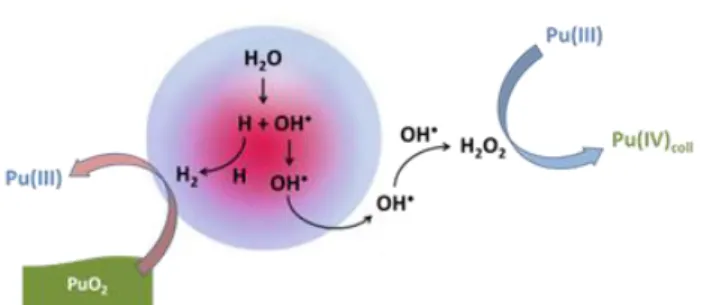HAL Id: cea-02339061
https://hal-cea.archives-ouvertes.fr/cea-02339061
Submitted on 13 Dec 2019HAL is a multi-disciplinary open access archive for the deposit and dissemination of sci-entific research documents, whether they are pub-lished or not. The documents may come from teaching and research institutions in France or abroad, or from public or private research centers.
L’archive ouverte pluridisciplinaire HAL, est destinée au dépôt et à la diffusion de documents scientifiques de niveau recherche, publiés ou non, émanant des établissements d’enseignement et de recherche français ou étrangers, des laboratoires publics ou privés.
Sonochemical Preparation and Characterization of
Intrinsic Pu Colloids
E. Dalodiere, M. Virot, V. Morosini, T. Chave, T. Dumas, C. Hennig, T.
Wiss, O. Dieste Blanco, D. Shuh, T. Tyliszcak, et al.
To cite this version:
E. Dalodiere, M. Virot, V. Morosini, T. Chave, T. Dumas, et al.. Sonochemical Preparation and Characterization of Intrinsic Pu Colloids. ESS16, Apr 2018, Besancon, France. �cea-02339061�
Sonochemical Preparation and Characterization of
Intrinsic Pu Colloids
Dalodière E.1, Virot M. 1,*, Morosini V. 1, Chave T. 1, Dumas T. 2, Hennig C.3, Wiss T.4, Dieste Blanco O.4, Shuh D. K.5, Tyliszcak T.5, Venault L.2, Moisy P.2, Nikitenko S. I.1
1ICSM Marcoule, UMR5257, Site de Marcoule, BP 17171, 30207 Bagnols-sur-Cèze,
France, 2CEA/DEN/MAR/DMRC, Nuclear Energy Division, Radiochemistry and
Process Department, BP17171, 30207 Bagnols-sur-Cèze, France, 3Helmholtz-Zentrum
Dresden-Rossendorf, Institute of Resource Ecology, Bautzner Landstrasse 400, 01328 Dresden, Germany, 4European Commission, Joint Research Centre (JRC), Institute for
Transuranium Elements (ITU), Postfach 2340, 76125 Karlsruhe, Germany, 5Chemical
Sciences Division, Lawrence Berkeley National Laboratory, One Cyclotron Road, Berkeley, CA 94720, USA.
Recent studies showed that plutonium migration into the environment can be facilitated by the presence and/or formation of colloids.[1,2] Particularly, intrinsic colloids are scarcely reported in the literature and their formation mechanism, stability and reactivity is poorly understood.[1,2]
Recently, it was shown that the extended sonication (20 kHz, 17 W.cm-2) of PuO2 in pure water leads, after centrifugation to remove big particles that did not react, to the formation of stable Pu colloids free from salt or stabilizing agents.[3] Formation kinetics and yields are found to increase with sonication duration and the specific surface area of the oxide. The investigations showed that both physical and chemical effects driven by acoustic cavitation are responsible for the formation of such intrinsic colloids. A two-step mechanism is proposed where the erosion and fragmentation of PuO2 particles first occur, followed by redox reactions which allow the accumulation in solution of Pu(IV) that can then hydrolyze and yield colloids (Figure 1). Among the various tested oxides, PuO2 is the only material exhibiting such a behavior. Sonochemical Pu colloids were compared to more classical colloids obtained by controlled hydrolysis of Pu(IV) beforehand stabilized in nitric media.
Both colloids were compared using several characterization techniques including UV-Vis absorption spectroscopy, TEM-HR, XAS, and STXM/NEXAFS. Results showed that both colloid suspensions are composed by quasi-spherical and crystalline PuO2 particles measuring 7 nm for sonochemical colloid, and 3 nm for hydrolytic colloid. The combination of EXAFS, STXM and TEM measurements allowed to distinguish the Pu-O coordination sphere and evidence a correlation between the number and distance of Pu-O interactions and the size of the particles. In comparison to sonochemical colloids, NEXAFS measurements showed that
hydrolytic colloid is much more influenced by hydrolyzed Pu(IV) species which finally allows us to generally describe Pu colloids as core-shell nanoparticles composed of quasi-stoichiometric PuO2 cores covered by hydrolyzed Pu(IV) species at the surface shell.[3]
Figure 1. Diagram of the proposed redox mechanism representing Pu(IV) colloid formation under ultrasound irradiation (20 kHz, Ar/10%CO, 20°C, 0.34 W mL-1)
References
[1] Novikov A. P., Kalmykov S. N., Utsunomiya S. et al. Science, 341(5799): 638–641. 2006. [2] Walther C., Denecke M. A., Chemical Reviews, 113(2): 995-1015. 2013.
[3] Dalodière E., Virot M., Morosini V. et al. Scientific Reports, 7(43514): 1-10. 2017.
